Table of Contents
💧 What to Do When Your Garbage Disposal Stops Working!
Facing a non-working garbage disposal can quickly escalate from a minor inconvenience to a major kitchen dilemma, potentially leading to clogged drains and the dread of expensive repairs. This guide is crafted to cut through the confusion, offering clear, actionable advice on diagnosing and fixing common disposal issues.
From jamming and humming to outright clogs, we lay out simple troubleshooting steps and preventive tips to restore your disposal’s functionality. Dive into this essential read to equip yourself with the knowledge needed to tackle garbage disposal problems swiftly, ensuring your kitchen’s smooth operation without delay.
💧 How a Garbage Disposal Works
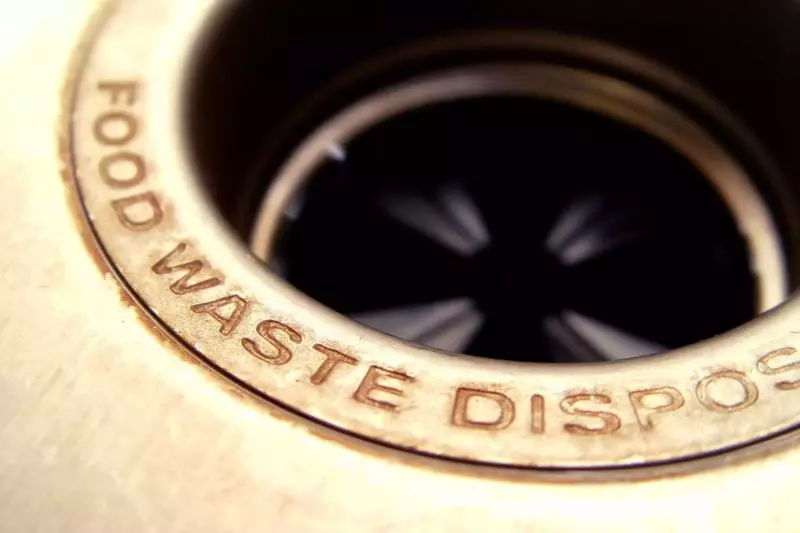
Garbage disposals are an incredibly useful appliance to have in a modern kitchen. But how do they work?
Here’s a simple breakdown of the disposal process:
- Food waste from your sink and the water is fed into the garbage disposal through the sink drain and collects in the grinding chamber.
- When you turn on the unit, a grinding plate at the bottom of the unit spins.
- This breaks down any food particles and reduces them to tiny pieces that can be further processed.
- The motor then pumps water around the grinding plate, which pushes the food waste out of the disposal and down the pipe toward your drainage system.
💧 First Steps of Troubleshooting a Garbage Disposal Repair
🧰 Conduct a Power Check
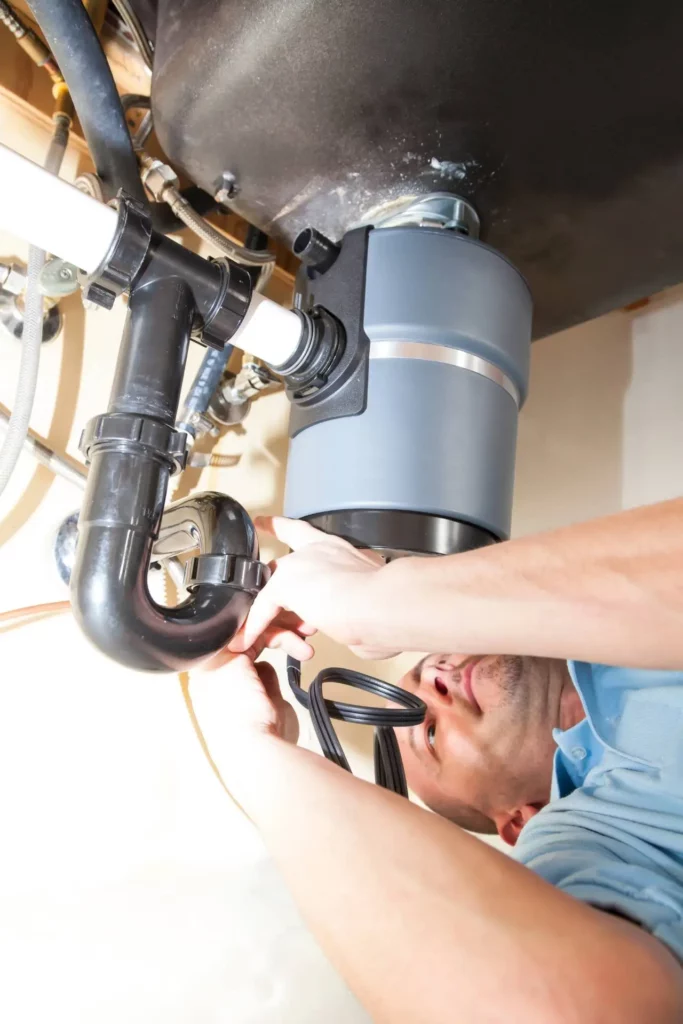
If your garbage disposal is not working correctly, it might be helpful to do a power check. First, check the unit and ensure it’s plugged in. Items stored under the sink can easily knock out the plug.
After checking the plug, hit the reset button on the bottom or the side of the unit. It may be on the back side, so feel around until you find it and press it firmly.
If it’s still not working, locate the circuit breaker in your home’s electrical panel and check it – if it has tripped, reset it. Finally, turn on the water and flip on the switch to test whether or not your garbage disposal is getting power.
If it still isn’t working after completing these steps, you may need to contact an electrician to check the wiring.
📗 Related Reading: How to Reset a Garbage Disposal
🧰 Rotate the Flywheel and Impeller Blades.
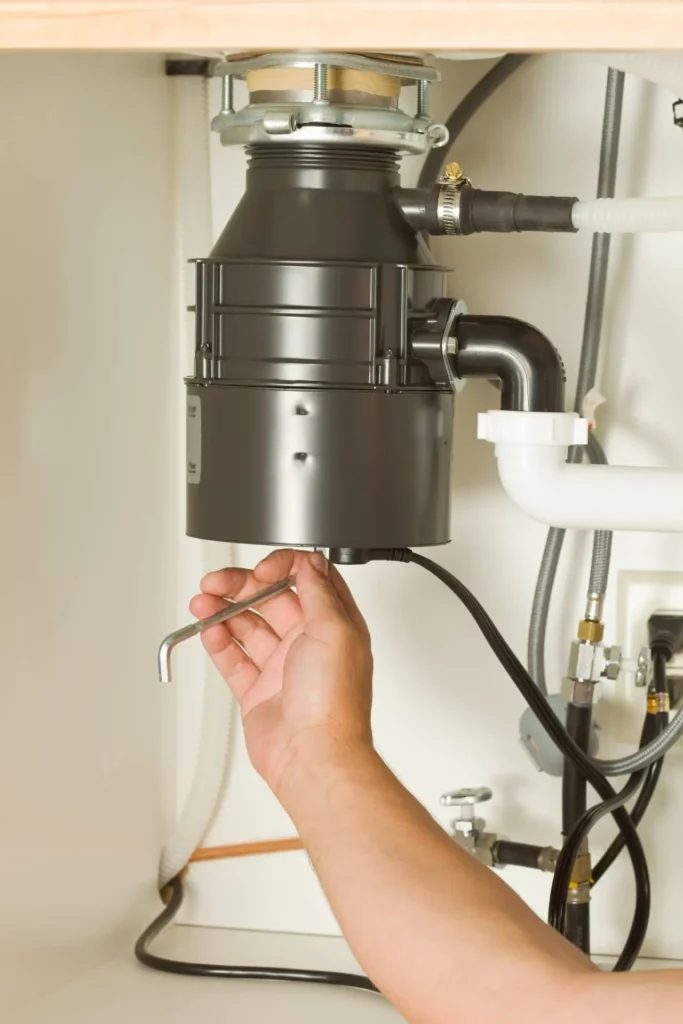
The flywheel or impeller blades may be jammed if your garbage disposal isn’t working correctly.
To unjam it, start by unplugging the power cord and turning off the circuit breaker to ensure there’s no power. Then, rotate the flywheel clockwise using a garbage disposal wrench (or a 1/4 ” hex head or Allen wrench).
If it does not move freely, apply medium pressure to help turn it carefully until the jam is released. Once you have done this, plug the unit back in and try turning on the switch again to ensure it works properly.
To check the impeller blades, use a wooden spoon or another wooden object as a lever to free the blades. You can use long nose pliers to pull out whatever may be stuck there.
✅ PRO TIP: Don’t put your fingers in the garbage disposal. If they can grind up bones, they can quickly grind up your fingers!
🧰 Check Under The Sink For Leaks.
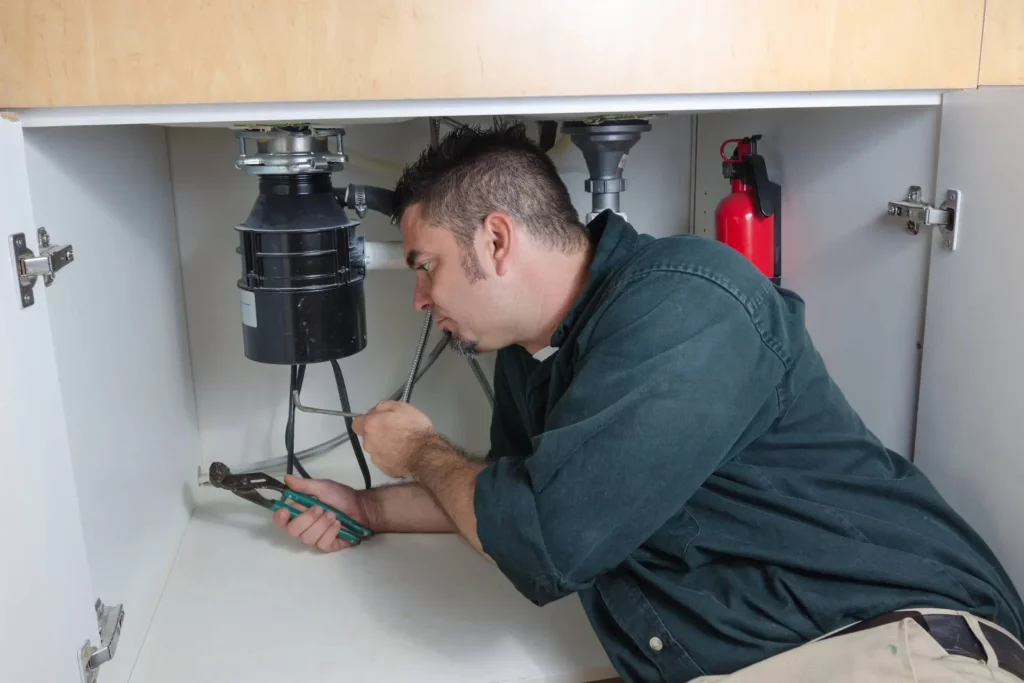
To check for water leaks, start by looking under the sink. Look for any puddles, water spots, or discolored areas under your sink or around the unit. If you find water, there’s likely a leak caused by loose plumbing connections or a cracked unit.
You can also rerun the unit with the water running to see if water leaks out of any drain connections while you are under there. If so, repair any leaks before using your garbage disposal again.
💧 How To Repair Common Garbage Disposal Problems
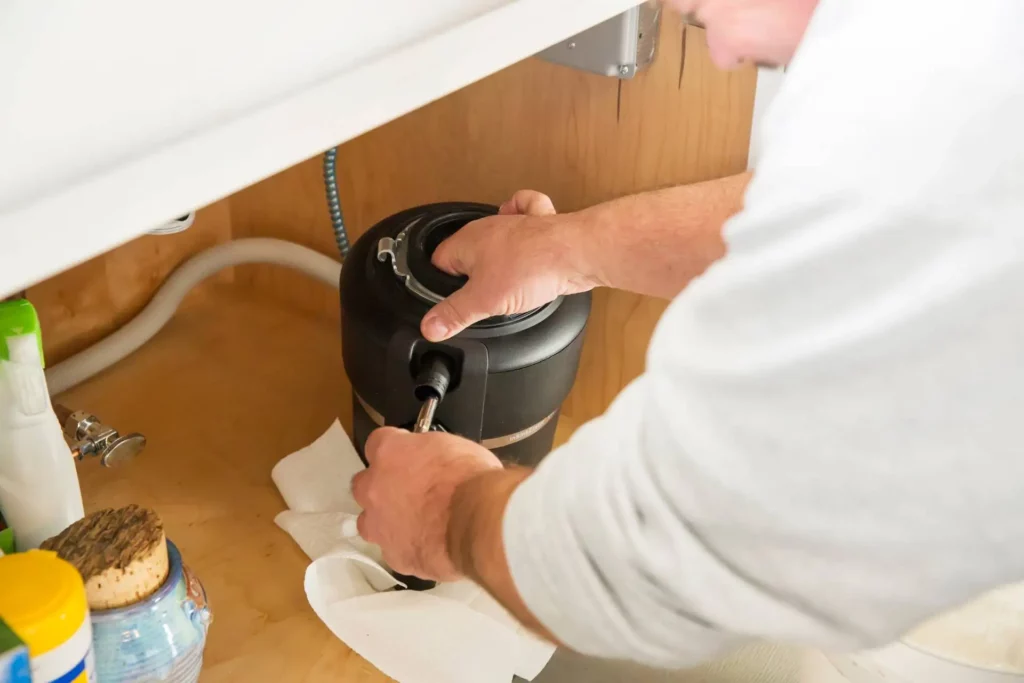
Garbage disposals are an essential kitchen appliance for many households, as they help quickly and easily eliminate food waste. Unfortunately, just like any other appliance, your garbage disposal can suffer from various problems that must be fixed.
From clogged impeller blades to jammed foreign objects, there are several common garage disposal issues that you can repair with the right tools and techniques.
Learn how to identify and resolve these common garbage disposal problems with the following troubleshooting tips.
🧰 Why Is My Garbage Disposal Humming But Not Running?
If the garbage disposal makes a humming sound but does not do anything when you switch it on, the flywheel inside the unit is likely jammed.
In this situation, it is crucial to stop the garbage disposal immediately, as continuing to run with a jam can burn out the motor and permanently damage the unit. If this happens, you may need to purchase a new disposal.
To fix this issue, follow the instruction above by rotating the flywheel and impeller blades to free up whatever is causing it to jam. After you have cleared the jam, switch the unit back on.
Press the reset button on the bottom of the unit and then run cold water down the drain for a few minutes while flipping the wall switch on and off in short bursts. This should help wash away any material left in the chamber.
If it doesn’t work and you still hear a humming noise, you should call a plumber for repairs or identify other issues with your garbage disposal such as rust or corrosion.
🧰 Why is my Garbage Disposal Smoking?
If your garbage disposal has stopped working and begins to smoke, it is likely due to a fried motor or a fried electrical circuit.
You should first turn off the power source and unplug the unit before taking further troubleshooting steps as per the above instructions:
- Remove the lower cover of the garbage disposal
- Examine the wires connecting to it – check for burnt wires
- If there are any burnt wires, remove them, as well as damaged wiring insulation
- Reinstall and reconnect any detached wiring
- Replace the lower cover
- Restore power and test out the unit
Call a plumber if these measures do not help or if you are uncomfortable dealing with electrical components. They will be able to determine if repairs can be done if your motor needs replacing or if the entire garbage disposal needs replacing.
🧰 Garbage Disposal Does Not Drain
If your garbage disposal isn’t draining, it is likely due to a clog. To troubleshoot this issue, try the following steps:
- Remove the waste from your sink and throw it in the trashcan.
- Use a plunger with about 2 inches of water in the sink and apply strong pressure to create a tight seal with the plunger over the drain opening. This may be enough to clear up any blockages entirely.
- If not, check down the drain for any obstructions and remove them with pliers or tongs. Rerun the garbage disposal to see if that works.
- Go under the sink, place a bucket under the disposal, and unscrew the bolts that fasten the discharge pipe to the unit.
- Disconnect the garbage disposal drain trap and pull out the disposal trap along with the discharge drain line. Check for blockages in this line and clear them out if found.
- If no obstructions are found in this line, use a sink auger in the drain line to clear out any possible clogs further down in the drainage system.
- If you have cleared the foreign object blockage, reattach all parts of your garbage disposal.
- Restore power and test it by running water into it – if it drains properly, you will have solved your problem!
If these measures do not help unclog your unit, call a plumber for further help, as there could be an obstruction further down in the drainage system that needs to be removed before your garbage disposal can work properly again.
🧰 Garbage Disposal Leaking
If your garbage disposal is leaking, it is likely due to improper installation or misalignment of the hose connections. To fix this issue, you should:
- Shut off the power to the garbage disposal and unplug it for safety.
- Check for any cracks in rubber fittings and replace them if found.
- Check for worn-out gaskets, o-rings, or other seals inside the unit that may have failed and are causing water to leak past them.
- Also, check the sink flange to see if it’s leaking from the top.
- Examine all hoses connecting to the disposal, ensuring they are securely connected.
- Check and firmly tighten down clamps on all hoses, including the discharge drainpipe.
Restore power to your disposal unit after all checks are complete, and test it with running water – if no leaks occur, you know you’ve fixed it!
🧰 You Might Need a New Garbage Disposal
If you have exhausted all other garbage disposal repair options to try and fix your broken garbage disposal, it’s likely time to consider purchasing a new one. Although installation can be intimidating, many articles or videos for most garbage disposals are available to walk you through the process.
If unsure how to properly install the new unit, seeking help from a professional plumber is often the best choice to avoid further damage or costly repairs.
📗 Related Reading: How To Remove a Garbage Disposal: Step-by-Step Guide
💧 Top Tips To Prevent Garbage Disposal Problems

Garbage disposals are often taken for granted, but it’s important to remember that regular maintenance and care can help keep your device working at its best.
Here are some helpful tips to prevent potential problems:
- Regularly clean the grinding plate of your garbage disposal to prevent clogging or jamming.
- You can do this by using ice cubes. Simply feed a cup of ice cubes into the disposal and run it for around 30 seconds. This will help sharpen blades and remove any lingering debris.
- Be careful not to overload the unit by only putting small amounts of waste down the disposal at a time.
- Run cold water while running the garbage disposal so that food particles get broken up before they can cause any damage.
- Avoid putting fibrous materials such as potato skins, banana peels, or celery stalks down the garbage disposal, as these can easily jam up the system.
How Long Do Garbage Disposals Last?
The average lifespan of a garbage disposal is between 8 and 12 years.
However, proper use and maintenance can extend the life of the unit.
Professional check-ups from a plumber can help keep your disposal running for longer.
What Can and Cannot Be Put Down a Garbage Disposal?
It is recommended only to put biodegradable waste, such as food scraps and vegetable peelings, down the garbage disposal.
Any non-biodegradable items, such as plastic or metal, should be kept out of the unit.
Certain items such as bones, eggshells, and fibrous materials should also be avoided.
How Often Should I Clean My Garbage Disposal?
It is important to regularly clean your garbage disposal to maintain its efficiency and prevent blockages.
It’s a good idea to clean the unit at least once every two weeks by pouring boiling water into the unit and occasionally using a drain cleaning agent or vinegar and baking soda for a more thorough cleaning.
Is It Okay To Use Dish Soap In The Disposal Unit?
You can use dish soap to freshen it up.
However, it’s best to use a specially designed drain cleaning agent, vinegar and baking soda, or even hot water and baking soda to clean the unit safely.
Are There Any Safety Precautions to Consider When Using a Garbage Disposal?
There are several safety precautions to consider when using a garbage disposal.
Ensure the power supply is turned off before performing any maintenance or cleaning tasks.
Wear gloves when pulling food waste or other debris from the unit.
Do not put hard items such as bones, eggshells, fruit pits, and metal objects into the garbage disposal as they could damage it.
Finally, Use a drain strainer or drain trap to filter large items before they go into the sink drain opening.
💧 Garbage Disposal Not Working? Call the Professionals
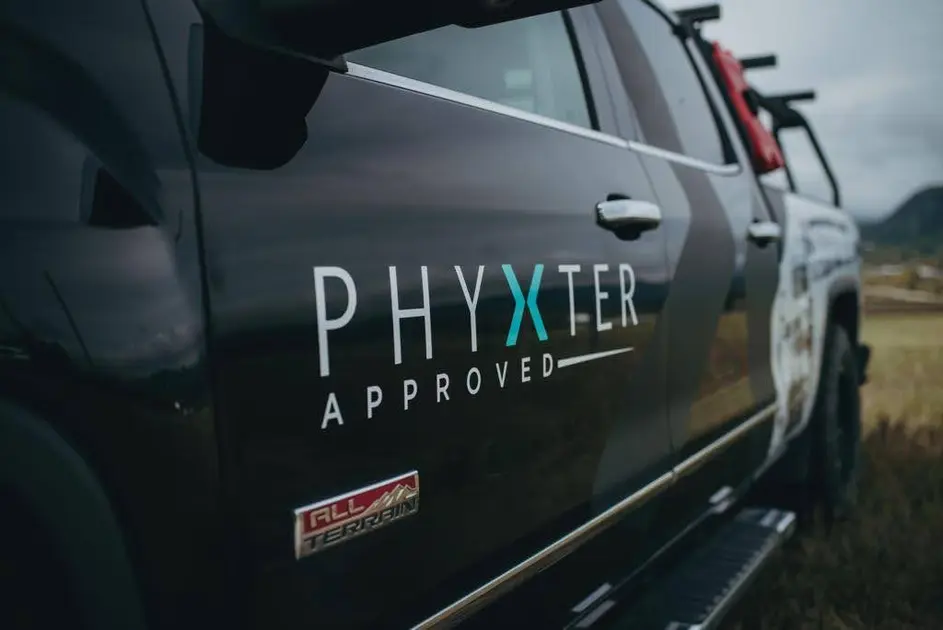
This article provides a comprehensive guide on troubleshooting and fixing common garbage disposal issues. It covers recognizing signs of malfunction, such as jamming, humming, stalling, or clogging and offers practical solutions to address these problems. The guide also includes tips for regular maintenance to prevent future issues and ensure your garbage disposal remains in optimal working condition.
Phyxter Home Services demonstrates extensive expertise and experience in home maintenance, particularly in managing garbage disposal challenges. Their advice is grounded in a deep understanding of household appliances, reflecting a commitment to providing high-quality, reliable information.
Exploring other plumbing articles in this category on Phyxter’s platform is highly recommended for homeowners seeking further insights into efficiently maintaining their home’s plumbing system.
📗 Related Reading: DIY Guide to 15 Common Plumbing Problems & Solutions

